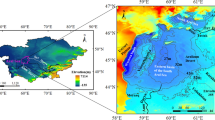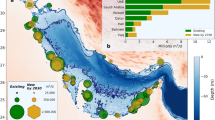Abstract
The Aral Sea was one of the largest lakes in the world before it started to shrink in the 1960s due to water withdrawal for agricultural irrigation. Precipitation decreased from 9.4 km3 in 1960 to 3.2 km3 in 2009, and annual river inflow into the Aral Sea decreased from 31.5 km3 in 1998 to 5.2 km3 in 2009. Comparison on the hydrological data of the Aral Sea between 1960 and 2009 showed the evaporation, water surface area, and water volume decreased by 90%, 80%, and 88%, respectively. This study employs the observed values of water volume, precipitation, runoff, evaporation, and salinity to estimate water volume and salinity from 1960 to 2009, and the efficiency coefficients for predicted water volume and salinity are 0.975 and 0.974, respectively. Regression equations calculated from the observed data are used to predict precipitation, runoff, evaporation, and salinity from 2010 to 2021, and the results are then applied in the estimation of water volume and salinity. Our estimates suggest that salinity will increase to around 200 g/L and water volume will decrease to around 83 km3 in 2021.
Similar content being viewed by others
References
Aralgenefund (2011) Evolution of the Aral Sea. http://www.aralgenefund.org/eng/evolution/ [Accessed on 2011-09-25].
Aladin NV, Potts WTW (1992) Changes in the Aral Sea ecosystem during the period 1960–1990. Hydrobiologia 237: 67–79.
Alley WM (1984) On the treatment of evapotranspiration, soil moisture accounting, and aquifer recharge in monthly water balance models. Water Resources Research 20: 1137–1149.
Alley WM (1985) Water balance models in one month ahead streamflow forecasting. Water Resources Research 21: 597–606.
Bari A (2011) Environmental Challenges of the Aral Sea and Aral Sea Area. Report Nukus, Uzbekistan. p 12.
Bortnik VN (1999) Alteration of water level and salinity of the Aral Sea. In: Glantz MH (eds.), Creeping environmental problems and sustainable development in the Aral Sea basin. Cambridge University Press, UK. pp 47–66.
Bjorklund G (1999) The Aral Sea — water resources, use and misuse. In: K Lindhal Kiessling (ed.), Alleviating the Consequences of an Ecological Catastrophe. Swedish Uniform Committee, Stockholm. pp 42–50.
Central Asian States (CAS) (2000) State of Environment of the Aral Sea basin. Regional Report of the CAS 2000. www.grida.no/aral/aralsea/-english/arsea/arsea.htm [Accessed on 2011-05-25]
Forkutsa I (2006) Modeling water and salt dynamics under irrigated cotton with hallow groundwater in the Khorezm region of Uzbekistan. University Bonn ZEF Series Ecological Development 37: 155–158.
Francois B, Philippe R (2004) A dynamic model of the Aral Sea water and salt balance. Journal of Marine Systems 47: 35–50.
Glazovsky NF (1990) A concept on the resolving of the Aral Crisis. Proceeding of the U.S.S.R. Academy of Sciences, Geographical Series 4: 28–41 (In Russian).
Islamov AB (1998) Aral Sea Catastrophe: Case for National, Regional and International Cooperation, by the Slavic Research Center. http://src-h.slav.hokudai.ac.jp/sympo/97-summer/islamov.html. [Accessed on 2006-10-27]
Jarsjo J, Destouni G (2004) Groundwater discharge into the Aral Sea after 1960. Journal of Marine Systems 47: 109–120.
Kostianoy AG (2006) Dead and Dying Seas. Encyclopedia of Water Science. Taylor and Francis. Doi: 10.1081/E-EWS-1200042068.
Legates DR, Mather JR (1992) An evaluation of the average annual global water balance. Geographical Review 82: 253–267.
Legates DR, McCabe GJ (2005) A re-evaluation of the average annual global water balance. Physical Geography 26: 467–479.
Micklin PP (2007) The Aral Sea Disaster. Annual Review of Earth and Planetary Sciences 35: 47–72.
Micklin PP (2004) Aral Sea Crisis. In: Nihoul CJ, Zavialov PO, Micklin PP (eds.), Dying and Dead Seas: Climatic Versus Anthropogenic Causes, NATO Science Series. Kluwer Academic Publishers, Dordrecht, Netherland. pp 99–123.
Micklin PP (1988) Desiccation of the Aral Sea: a water management disaster in the Soviet Union. Sciences 241: 1170–1176.
Mikhailov VN, Kravtsova VI, Gurov FN, et al. (2001) Assessment of the present day state of the Aral Sea. Vestnik Moskovskogo Universiteta (Moscow University Gerald). Serial 5, Geography 6: 14–21. (In Russian with English abstract)
Mather JR (1969) The average annual water balance of the world. In: Symposium on Water Balance in North America, Series No. 7, Proceedings: Banff, Alberta, Canada, American Water Resources Association. pp 29–40.
McCabe GJ, Ayers MA (1989) Hydrologic effects of climate change in the Delaware river basin. Water Resources Bulletin 25: 1231–1242.
McCabe GJ, Wolock DM (1992) Sensitivity of irrigation demand in a humid-temperate region to hypothetical climatic change. Water Resources Bulletin 28: 535–543.
Mintz Y, Serafini YA (1992) A global monthly climatology of soil moisture and water balance. Climate Dynamics 8: 13–27.
Nash JE, Sutcliffe JV (1970) River flow forecasting through conceptual models. Part 1-A: discussion of principle. Journal of Hydrology 10: 282–290.
Oroud IM (1999) Temperature and evaporation dynamics of saline solutions. Journal of Hydrology 226: 1–10.
Oteniyazov E (2005) Ecologic situation of the Aral Sea region. NATO Science Series 1: 13–16.
Ptichnikov A (2002) Sustainable development of ecology, land and water use through implementation of a GIS and Remote Sensing Centre in Karakalpakstan. Bulletin 3, NATO Science Peace Project. 974101. Uzbekistan, Moscow (In Russian with English abstract).
Qin BQ, Huang Q (1998) Simulation of energy and water budget of Qinghai Lake, China. Chinese Journal of Oceanalogy and Limnology 16: 289–297.
Sevastyanov DV, Smirnova NP (1986) Issyk-Kul lake and the tendency of its natural development. Nauka, Leningrad. p 256 (In Russian).
Thornthwaite CW (1948) An approach toward a rational classification of climate. Geographical Review 38: 55–94.
UNDP (2007) Water, critical resource for Uzbekistan’s future. UNDP Program, Tashkent. p 121.
UNDP (2008) Review of donor assistance in the Aral Sea region, UNDP, Tashkent. http://www.undp.uz/en/publications/publication.php?id=99. [Accessed on 2008-03-01]
UNESCO (2000) Water related vision for the Aral Sea basin for the year 2025, UNESCO, Paris. p 237.
UNEP (2006) Aral Sea Basin Program, UNEP/GRID-Arendal [on-line]. [Accessed on 2006-08-01]
U.S Geological Survey (2007) Earthshots: Aral Sea. U.S. Department of the Interior. [Accessed on 2011-04-15]
Wolock DM, McCabe GJ (1999) Effects of potential climatic change on annual runoff in the conterminous United States. Journal of the American Water Resources Association 35: 1341–1350.
Zavialov PO, Kostianov AG, Emelianov SV, et al. (2003) Hydrographic survey in the dying Aral Sea. Geophysical Research letter 30(13): 1959.
Author information
Authors and Affiliations
Corresponding author
Rights and permissions
About this article
Cite this article
Gaybullaev, B., Chen, SC. & Kuo, YM. Large-scale desiccation of the Aral Sea due to over-exploitation after 1960. J. Mt. Sci. 9, 538–546 (2012). https://doi.org/10.1007/s11629-012-2273-1
Received:
Accepted:
Published:
Issue Date:
DOI: https://doi.org/10.1007/s11629-012-2273-1




